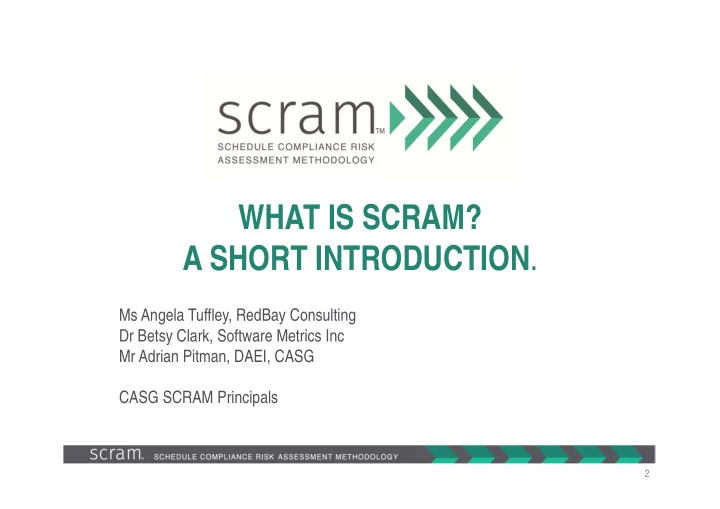

WHAT IS SCRAM? A SHORT INTRODUCTION . Ms Angela Tuffley, RedBay Consulting Dr Betsy Clark, Software Metrics Inc Mr Adrian Pitman, DAEI, CASG CASG SCRAM Principals 2
Schedule Compliance Risk Assessment Methodology: SCRAM SCRAM is a methodology that has evolved from reviews of CASG Projects of Interest and Concern Schedule is almost always the primary concern of project stakeholders SCRAM is a key component of CASG’s initiatives to improve schedule performance 3
Setting The Scene In the following video, these Defense Contractors promised to delivered two months ahead of the competitive bid.
Setting the Scene
What does SCRAM mean? Go away! Schedule Compliance Risk Assessment Methodology Secure Continuous Remote Alcohol Monitoring – As modelled here by Lindsay Lohan 6
SCRAM has been developed To benefit decision makers, program managers and the acquisition community… by providing a methodology that assists programs / projects… to consistently identify root causes of schedule slippage and recommend remedial action. 7
What is SCRAM? • Quantifies the schedule impact of issues and An independent review risks using scientific analysis techniques to identify issues and • Schedule Monte Carlo Simulation risks to schedule • Software Parametric Modelling Embodies best • Systems and software engineering practices • Schedule development and project execution Facilitates improved • Based on feedback from reviews business practices • Identification of systemic root causes / issues 8
SCRAM Usage Sponsored by the • To improve Project Schedule Performance in response to Government concern as identified by the Australian Australian National Audit Office (ANAO) Department of • Successfully applied to the F-35 JSF Program in the USA and was used to monitor software development Defence performance on the program 9
Diversity of SCRAM Reviews Satellite Aerospace Ground Stations (F-35, MRTT, Hawk, Wedgetail) (JP2008) Enterprise Resource Maritime Planning (Anzac, AWD) (MILIS) Telecommunications Training Systems (HFMOD, LAND2072) (F-35 ALIS, HATS, PTS) 10
SCRAM Delivery Modes: Pre-emptive • Prior to contract award and/or EVM-IBR Assurance • At any point in the project lifecycle Diagnostic • When a project is of interest or concern 11
What SCRAM is NOT An Audit • It does not focus on identifying non-conformance A Process • Like Capability Maturity Model Integration (CMMI) • But SCRAM does identify and treat poor process performance Assessment as an issue if process is driving schedule slippage 12
Organising Project Information Program Managers are flooded with information, making it difficult to distinguish between symptoms and root causes of schedule slippage To de-clutter and organise the massive amounts of information, SCRAM Assessors utilise a thought model Root Cause Analysis of Schedule Slippage (RCASS) 13
Categories of Information
Root Cause Analysis of Schedule Slippage (RCASS) 16
SCRAM Review Process
SCRAM Review Key Principles Minimal Independent Non-advocate Disruption • Artefact Review (plans, • SCRAM Team members • All significant issues and procedures, model are organisationally concerns are considered evidence) conducted independent of the and reported regardless offline program under review of origin or source (Customer and/or • Some SCRAM reviews • Information is collected Contractor). have been joint one person at a time contractor/customer team • Interviews typically last – facilitates joint an hour commitment to resolve review outcomes 18
SCRAM Review Key Principles Corroboration of Rapid turn- Non-attribution Evidence around • Information obtained is • Significant Findings and • One to two weeks spent not attributed to any Observations based on on-site individual at least two independent • Executive out-briefing sources of corroboration • Focus is on identifying presented at end of and mitigating the second week issues/risk • Written report two weeks later 19
SCRAM Review Key Principles Sharing Results • Openness and Transparency • For the parametric modelling component of a SCRAM Review, the organisation may witness data analysis and challenge results • Preliminary out brief of findings is delivered prior to departure from review site • Builds cooperation and trust • Builds confidence in the schedule forecast • However, the SCRAM Team is the final arbiter 20
Two Methods of Quantifying Schedule Risk Schedule Risk Analysis (SRA) Parametric Software Modelling • Provides a detailed view • Provides a high-level view • Risks to schedule compliance are • Forecast completion date can be performed at the level of specific risks determined based on product size and specific tasks in the Project (SLOC), historical data and achieved Schedule using a Monte Carlo simulation productivity The two techniques provide independent estimates of schedule compliance probability 21
22 Schedule Risk Analysis/Monte Carlo
23 Parametric Software Modelling Forecast
24 Putting All Together
25
Recommend
More recommend